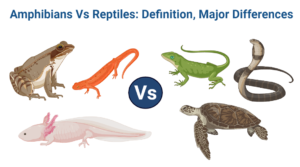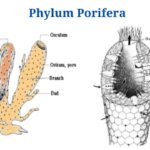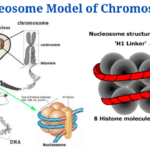Definition of Amphibians
A type of cold-blooded animals that can live in aquatic as well as terrestrial environments are Amphibians.
- In Greek, the word “amphibios” means to live twice, hence the phrase “amphibian.”
- Although several species within the category of amphibians may be stable land residents, others may be permanent aquatic dwellers, the title represents the dual lives of these animals.
- There are roughly 8100 amphibians’ species present on this planet. The earliest organism appeared about 370 million years ago.
- There are three orders of modern amphibians, each of which comprises numerous animal species.
- The Order Anura comprises of toads plus frogs, the Order Caudata comprises of salamanders plus newts, and the Order Apoda comprises of caecilians.
- The three orders are distinguished by their distinct looks or architecture.
- Frogs don’t have a tail, but they really do have two sets of limbs, with the hindlimbs generally lengthier as well as stronger. Salamanders possess nearly the very same size tails and limbs. The caecilians, on the other hand, have evolved to dwell in burrows and therefore are limbless.Many amphibians may have some qualities in common.
- Even though most amphibians’ skin is wet, they depend primarily on cutaneous respiration. Certain frogs as well as salamanders on land may indeed be completely lacking lungs.
- Such animals’ larval forms usually feature gills, that allow the young to survive in the water. As when the larva matures into an adult, the gills vanish.
- Such creatures have a dual system of hearing as well as green rods in their retinas that allow them to distinguish between different colours.
- Internal or external fertilisation is used by amphibians to reproduce sexually. To attract mating partners, they have particular fragrances or mating cries.
- Amphibians are obligate water breeders because they do not create amniotic eggs. The growing larva swims about looking for food but escaping predators after the mother deposits her eggs in water.
- Internal fertilisation, on the other hand, causes the young to grow inside the female’s oviduct, feeding on duct walls.
- Due to their porous eggs and semipermeable skin, amphibians are one of the most vulnerable species in the environment.
Image Created with BioRender
Definition of Reptiles
Reptiles are land-dwelling, cold-blooded vertebrates with epidermal scales covering part or else the complete body surface.
- Within reptiles, animal features may differ, with some reptiles resembling amphibians and others resembling birds.
- The majority of reptiles are tetrapods, meaning they have two pairs of limbs and lack the aquatic larval stage.
- There are about 10,000 kinds of reptiles on the planet. The earliest reptiles appeared about 312 million years ago.
- Based on their outward appearance, modern reptiles are classified into four orders.
- Squamata contains lizards plus snakes; Crocodilia has crocodiles plus alligators; Testudines contains turtles plus tortoises; and Sphenodonta contains tuarata.
- Extinct reptiles are far extra varied, spanning from aquatic plesiosaurs to meat-eating terrestrial dinosaurs.
- The epidermal coating on the skin of most reptiles is made up of beta-keratin. These scales vary in shape and size based on the species.
- They have a very well respiratory system since they are creatures who breathe air. Certain reptiles possess two sets of limbs, while others don’t have any at all.
- The outer layer of a reptile’s skin is shed on a regular basis. Their metabolism fluctuates depending on the surrounding temperature since they are cold-blooded.
- The majority of them reproduce sexually, and sexual reproduction takes place internally, with sperm being deposited by copulation. In certain communities, parthenogenesis is used to produce asexual offspring.
- Just boas as well as pythons give birth to live offspring; the others make a small nest in which to lay their eggs. The eggs are amniotic and encased in calcareous shells.
- The temperature of the soil is crucial throughout the hatching process, which takes a few days or else one month. The sex of the young is determined by the temperature of the soil.
- The majority of reptiles are nocturnal creatures with enhanced colour perception as well as visual depth.
Difference between Amphibians and Reptiles
(Amphibians Vs Reptiles)
| Basis for Comparison | Amphibians | Reptiles |
| Definition |
Amphibians are a type of cold-blooded animal which can live in aquatic as well as terrestrial environments. |
Reptiles are land-dwelling, cold-blooded vertebrates with epidermal scales layering a fraction or the whole body surface. |
| Distinct feature | Amphibians dwell in two states. |
Reptiles are animals that slither or crawl. |
| Skin |
Amphibian skin is smooth, wet, permeable, as well as occasionally sticky, having a number of mucus glands. |
On the skin, dry scales are organized in a specific pattern. The actual skin can be found beneath the keratin-based dry scales. |
|
Amphibians have glands on their skin that create toxic fluids like the protection method against predators. |
Reptiles don’t have glands on their skin. |
|
| Respiration | Many adult amphibians breathe through their skin, but several contain lungs as well. A newborn tadpole in water breathes through its gills. |
Reptiles cannot breathe via their skin and rely on pulmonary respiration as their primary mode of respiration. |
| Limbs |
Their forelimbs are short, while their hindlimbs are long, with five webbed digits. |
Apart from for snakes that don’t contain limbs hence crawl on land, they normally have four limbs. |
| Heart |
Amphibians, have three-chambered heart containing two auricles plus a ventricle. |
Having two auricles and a wrongly divided ventricle, the reptile heart contains three chambers. Crocodiles have the only four-chambered heart among reptiles. |
| Eyes |
Amphibians have a limited colour range and are unable to distinguish between a variety of hues. |
Color perception and visual depth are superior in reptiles. |
| Tongue |
The tongue of an amphibian is typically whole, though some may have a bifurcated tip. |
Reptiles have a bifurcated tongue, which is a distinguishing trait. |
| Cranial nerves |
There are ten pairs of cranial nerves in amphibians. |
There are 12 pairs of cranial nerves in reptiles. |
| Evolution |
About 370 million years ago, the earliest amphibians were discovered. |
About 315 million years ago, the earliest reptiles were discovered. |
| Species |
A total of 5500 amphibian species have been recognised worldwide. |
Around 6500 reptile species have been identified around the world. |
| Nitrogenous waste |
Ammonia is the most common nitrogenous waste produced by amphibians. |
In reptiles, uric acid is the most common nitrogenous waste. |
| Fertilization |
Amphibians use external fertilisation. |
Reptiles have internal fertilisation. |
| Eggs | Amphibian eggs are laid in water with a layer of gel on top. | Reptiles eggs are laid on land as well as protected with a hard, calcareous, leathery shell. |
| Larva |
Amphibians have an aquatic larval stage in their life cycle. |
In the reptile life cycle, there is no aquatic larval form. |
Amphibians examples
(a) Frog
- Frogs are tailless amphibians that belong to the Phylum Amphibia’s order Anura.
- The majority of frogs are aquatic, but certain dwell on land as well as water, while others are completely terrestrial.
- A mature frog has a strong body with two sets of limbs and bulging eyes. The forelimbs are short and feeble, whereas the hind legs are long and strong.
- To breathe, a frog’s body is covered in moist skin, just like other amphibians. Frogs without lungs have also been observed.
- As a protection mechanism, certain frogs’ skin contains numerous glands that release hazardous fluids.
- Frogs contain a long tongue which stretches approximately a third of their body length.
- Their tongues are very sticky, allowing them to grab prey. Adult frogs eat largely insects and are mostly carnivorous.
- Frog breeding takes place throughout the rainy season as well as in freshwater. Mating cries or mating fluids are used by frogs to attract their partners.
- It’s possible to fertilise them internally or externally, but they always reproduce by laying eggs instead of sperm. As soon as the tadpole hatches, it will reside in the water.
(b) Salamander
- Salamanders are amphibians with a lizard-like body, two pairs of short limbs, plus a tail that have a strong elongated body, two pairs of short limbs, and a tail. Several of them may resemble eels.
- Salamanders, just as frogs, have a wide range of species. The majority of them spend their entire lives in water, while some migrate to and from the water on a regular basis, and several are completely terrestrial.
- Salamander skin is thin, water-permeable, as well as possesses many glands to maintain the moisture. Cornified layers of the skin are lost on a regular basis.
- The skin possesses cryptic hues that allow them to use a concealment strategy.
- The majority of salamanders are predators that eat crabs, fish, and small mammals. Both the upper and lower jaws of adult along with young salamanders contain teeth.
- In around 90% of them, fertilisation occurs internally, with the male spreading sperm on the ground, that is subsequently picked up by the female.
- They emerge in a few weeks from their eggs, and spend most of their time in water. In order to become an adult salamander, it must go through metamorphosis first.
Reptiles examples
(a) Crocodiles
- Crocodiles are typically aquatic reptiles who grow to be around 2 metres long and their weight is around 1000 kilogrammes.
- You can tell they’re slimy because of their keratinized scales on their bodies. As a result, the creatures will be able to survive in the water more easily.
- Large fangs, two pairs of short limbs, clawed webbed feet, and a huge tail are all known features of this creature.
- The crocodile’s body shape allows it to stay in the water despite the fact that its ears, nose, and eyes are outside.
- These are cold-blooded species, therefore they interchange among swimming in the sun and swimming in the shade to keep the temperature of their body stable. To remain warm throughout the winter, they dig large burrows.
- Internal fertilisation occurs primarily in the water. On the other hand, lay their eggs in the ground usually inside holes.
- The little ones grow for around two to three months before they are ready to fledge. For several weeks to months, the female protects the young from predators and other predators.
(b) Turtle (Are turtles Amphibians or Reptiles?)
- Turtles are reptiles having a bone shell that includes on top a carapace, and on the bottom, a plastron.
- A turtle’s shell is made up of bones and cartilages and is an important organ. The turtle’s shell is retained throughout its life and isn’t shed like that of other reptiles.
- Based on the species, turtles either dwell on land or in water.
- There are robust beaks and jaws on the skulls of tortoises that help them chew and cut food.
- They contain two pairs of webbed feet as well as two pairs of limbs. They have a reputation for moving slowly. Flippers may be used instead of legs by some sea turtles.
- Internal fertilisation occurs, and eggs are laid by them on land. Unlike crocodiles, Turtles, don’t display care by parents following birth.
Amphibians Vs Reptiles Citations
- https://www.schoolandcollegelistings.com/US/Fort-Worth/387853508036428/Longhorn-Activity-Center
- https://www.britannica.com/animal/amphibian
- https://veteriankey.com/cranial-nerves/
- https://www.worldatlas.com/what-are-amphibians.html
- https://www.worldatlas.com/articles/are-salamanders-amphibians.html
- https://www.reference.com/pets-animals/examples-reptiles-a29eaa74b4db1ee5
- https://www.livescience.com/zoonotic-disease.html
- https://www.ias.ac.in/article/fulltext/secb/020/01/0001-0029
- https://www.differencebetween.com/difference-between-fish-and-vs-amphibians/
- https://www.britannica.com/animal/turtle-reptile
- https://www.answers.com/Q/What_animal_lives_only_on_land_but_lays_eggs_in_the_water
- https://www.answers.com/Q/How_do_cold_blooded_animals_keep_warm
- https://www.answers.com/Q/Do_fish_have_two_pairs_of_limbs
- https://www.activewild.com/amphibians/
- https://wikimili.com/en/Frog
- https://quizlet.com/203440520/vertebrates-cold-blooded-and-warm-blooded-animals-flash-cards/
- https://monarchjointventure.org/resources/faq
- https://kids.kiddle.co/Salamander
- https://encyclopedia2.thefreedictionary.com/frog
- https://en.wikipedia.org/wiki/Turtle_shell
- https://bio.libretexts.org/Bookshelves/Introductory_and_General_Biology/Book%3A_Introductory_Biology_(CK-12)/12%3A_Vertebrates/12.13%3A_Amphibian_Reproduction_and_Development
- https://animalsake.com/reptiles-characteristics-of-reptiles
- http://www.bio.miami.edu/dana/dox/nitrogenouswaste.html
Related Posts
- Phylum Porifera: Classification, Characteristics, Examples
- Dissecting Microscope (Stereo Microscope) Definition, Principle, Uses, Parts
- Epithelial Tissue Vs Connective Tissue: Definition, 16+ Differences, Examples
- 29+ Differences Between Arteries and Veins
- 31+ Differences Between DNA and RNA (DNA vs RNA)
- Eukaryotic Cells: Definition, Parts, Structure, Examples
- Centrifugal Force: Definition, Principle, Formula, Examples
- Asexual Vs Sexual Reproduction: Overview, 18+ Differences, Examples
- Glandular Epithelium: Location, Structure, Functions, Examples
- 25+ Differences between Invertebrates and Vertebrates
- Lineweaver–Burk Plot
- Cilia and Flagella: Definition, Structure, Functions and Diagram
- P-value: Definition, Formula, Table and Calculation
- Nucleosome Model of Chromosome
- Northern Blot: Overview, Principle, Procedure and Results

















